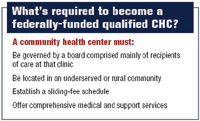How to open the door to publicly funded health care for patients in need
Part three of three: Access and enrollment
DR. FINE is a hospitalist, pediatric gastronenterology, and clinicalinstructor at Children's National Medical Center, Washington, D.C.He has nothing to disclose in regard to affiliations with, or financialinterests in, any organization that may have an interest in any part ofthis article.
In the first two parts of this three-part series, Medicaid and State Children's Health Insurance Program (SCHIP) eligibility and benefits were detailed,1 and the programs' financing and reimbursement were discussed.2 In this concluding installment, challenging issues of access that face low-income children and obstacles to enrollment in public health care programs are explored in brief.
Access to care
Health care coverage does not translate into access to health care. Although programs such as Medicaid and SCHIP often finance the care of low-income children, significant obstacles can prevent them from seeing a pediatrician for necessary acute and preventive services.3 A child may be eligible for comprehensive early and periodic screening, diagnosis and treatment (EPSDT) benefits as a Medicaid enrollee, but there is no certainty that those benefits will be utilized. A major reason for this problem has been a lack of providers in some areas. It has been documented that, for social and economic reasons, pediatricians more often than not open their practice or join a practice in large metropolitan areas-thereby leaving other geographic regions underserved.4
Additionally, reimbursement issues that plague Medicaid programs in many states can dissuade pediatricians from electing to provide care to the low-income population. The Virginia Chapter of the American Academy of Pediatrics, for example, has stated that, given the low reimbursement rate, pediatricians must limit their practice to 10% Medicaid patients-or risk insolvency.5
These access issues are not new. In 1965 (the same year Medicaid legislation was passed), the US Office of Economic Opportunity noted that serious health problems face poor urban and rural communities. As a result, community health centers (CHCs) were born that year as a federally-supported effort to improve access to care for low-income people.4 Although access issues still exist, the situation would be far more dire without CHCs providing comprehensive preventive, acute, and chronic health care services-often, including mental health, dental, and developmental evaluations-to the poor and near-poor.

Once a clinic is recognized as a community health center, it is eligible for certain federal assistance beyond grants. For example, CHCs are given preferential access to the Vaccines for Children program to provide CDC-recommended immunizations. They are also given assistance with administrative services to assist with child enrollment in publicly financed health programs and are able to draw providers from the National Health Service Corps, which recruits clinicians with the lure of loan repayment and other benefits.
Community health centers get most of their dollars from federal grants and from Medicaid. Even though they also get state or local financial support, solicit philanthropy, and can collect some fees from serving Medicare and private insurance patients and through patients' co-payments, they subsist mainly on Medicaid. Cuts to Medicaid reimbursement, therefore, represent a threat to the well-being of these centers.